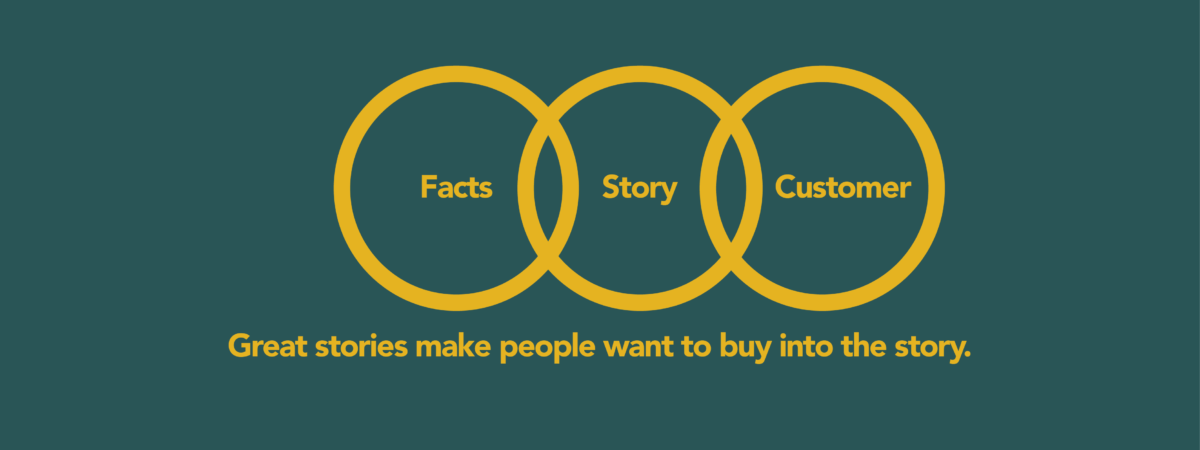Communicators love the idea of a story.
However, while we intellectually grasp the value of “telling a story” and see how an emotional vehicle can make products and brands more interesting, we still struggle to see how “telling a story” equals “making a sale”.
Worse. We can’t explain it to the Keynesian economists in the C-Suite.
There is an undeniable benefit to telling a story.
Stories make facts memorable.
A simple case in point.
Take two unremarkable facts.
Mrs Smith died.
And Mr Smith died.
Two facts destined to be cast into the dustbin of your memory
But turn it into a story and it becomes almost unforgettable.
“Mrs Smith died. And Mr Smith died of a broken heart.”
Simple. Emotional. Unforgettable.
Stories don’t need to be long.
Ernest Hemmingway often said the best story he ever wrote was six words long.
“For sale. Baby shoes. Never worn.”
Simple. Emotional. Unforgettable.
One key is keeping it simple.
People crave simplicity.
As marketers, advertisers and communications specialists we understand the power of simplicity and clarity.
Simplicity to cut through the chaos.
Stories to provide context and meaning to the thing we’re trying to sell.
Because people understand stories.
Because people respond to stories.
As long as they’re simple stories, relevant stories, told in the right way.
Stories create value.
Commercial value is the difference between what a thing costs to get to market and what the market is prepared to pay for it.
Ludvig von Mises (Austrian economist and sociologist) claimed all value is perceived value.
Value is created by the story we believe about the product.
Diamonds are valuable because of the story we have built up around them.
Gold is valuable because of the story we have built around it.
We pay what we think a thing is worth.
Commercial value is determined by what we, and others, believe it to be.
It’s why the cool kids in the 90s were prepared to pay $40 for a pair of Raybans it cost about $1 to make.
As the great Ludvig also said, “The most logical endpoint of desire is consumption.”
Why aren’t more people telling stories to sell products?
Because, it’s not an easy 3 step process.
Because facts are easy to find but emotions are messy.
Because, too often we take the logical route.
Because great stories lie outside the logical boundaries of the product.
And a lot of business people see the exploration beyond the immediate logic as a waste of time – and no one has time for that these days.
Because, too often, we skip beyond the great story and try and find the grand purpose – and customers don’t care about saving the world as much as they care about getting their clothes clean.
Because we think to be clever, we need to show how clever we are. As Warren Buffett said, “…. business schools reward difficult, complex behaviour more than simple behaviour, but simple behaviour is more effective.”
Because we don’t find the link between the emotion and the facts.
We boil the facts down, over and over again, like a master distiller, desperate to find the intoxicant we can feed to our customers.
Then try and bolt the emotion onto the benefit in order to make the sale.
It’s wrong.
Not because of the emotion.
But because of the relevance.
There is a better way.
The emotion is the benefit.
The emotion is the value.
Price only matters when nothing else matters.
Instead of trying to find the logical benefit, start by identifying the emotional connector.
What is the relevant emotion?
What drives your market?
What do they really want?
(It’s rarely, “A cheaper toaster”. More likely it’s, “A quiet house in the morning.”)
Then understand the story you can tell them that connects what they want with what you’ve got.
Simple communications work best.
Create clear, simple, stories about their lives with your product.
Then include the logical underpinning.
So, you can create clear communications which invite a response.
The story is not the brand.
Each message is a story in itself.
Each story becomes part of a bigger story.
Think of each communication as a cell, replicating and re-replicating, to form a larger story.
The cell, seen in isolation, seems like any other cell.
But, when replicated and multiplied, it becomes something individual.
Each cell contains the DNA of the final outcome.
Each cell supports and adds to the work of every other cell.
In classic marketing terms, this would be the work of the brand guidelines, clear frameworks which underpin and support each message to provide consistency and relevance. (Another story, for another day.)
Tell a simple story.
Then tell another simple story.
This is how creatures are made.
This is how brands are made.
This is how legends are made.
This is how we become famous.


Leave A Comment